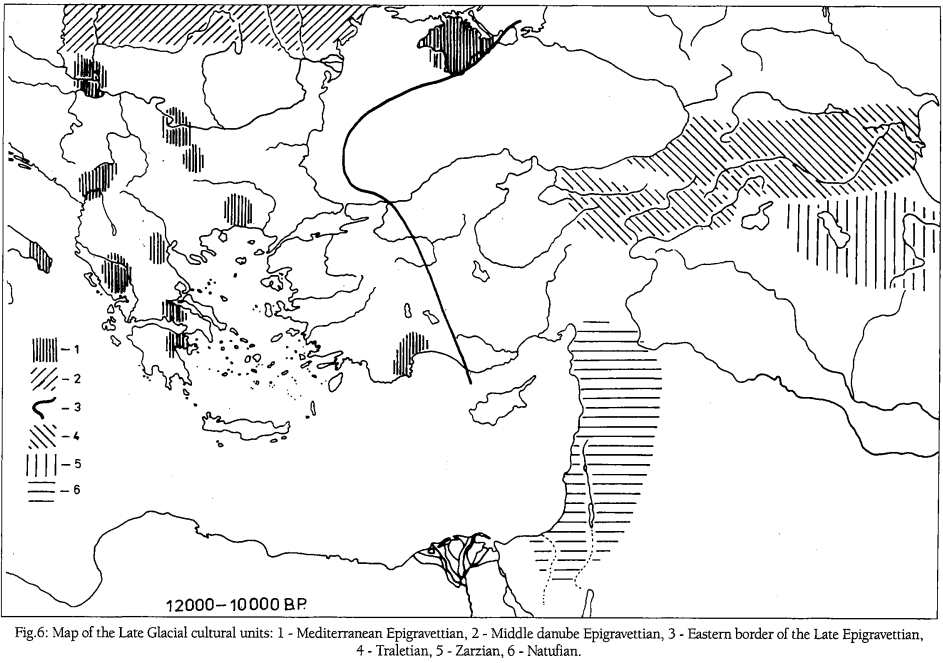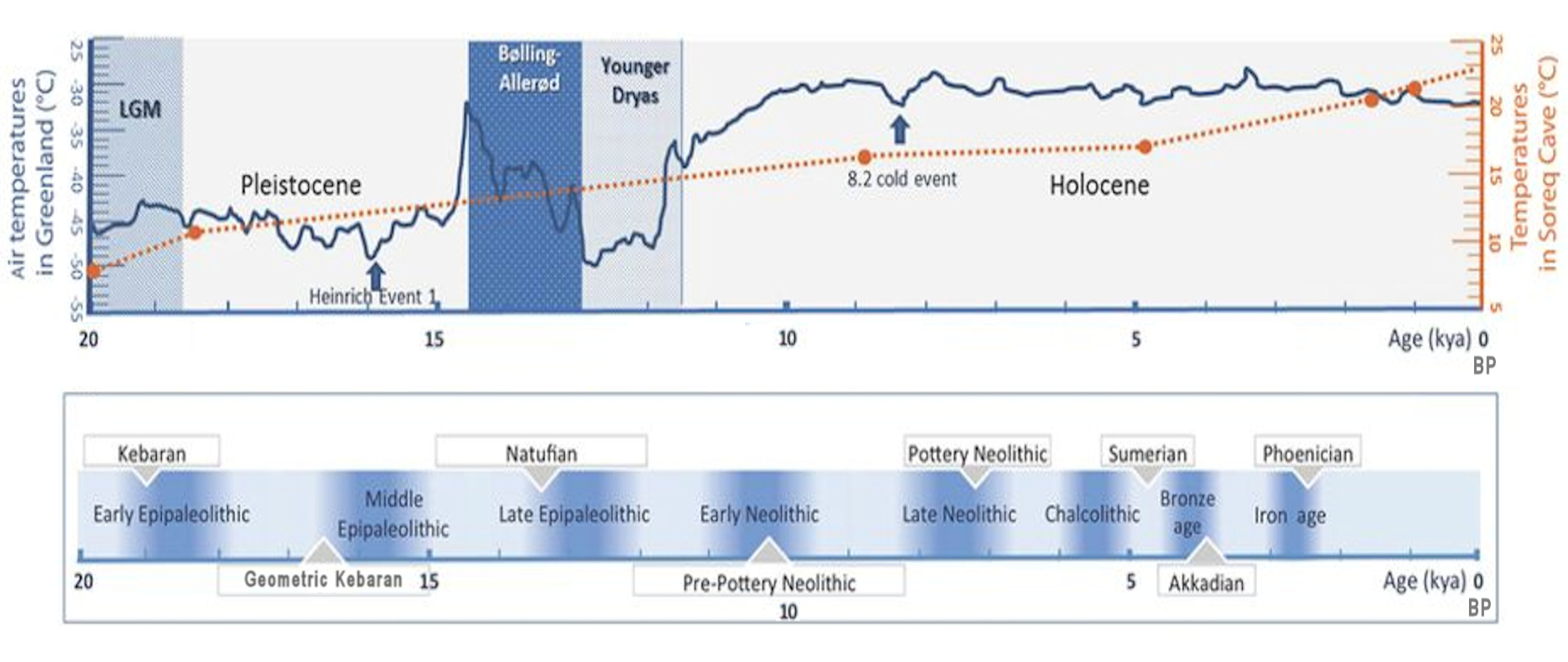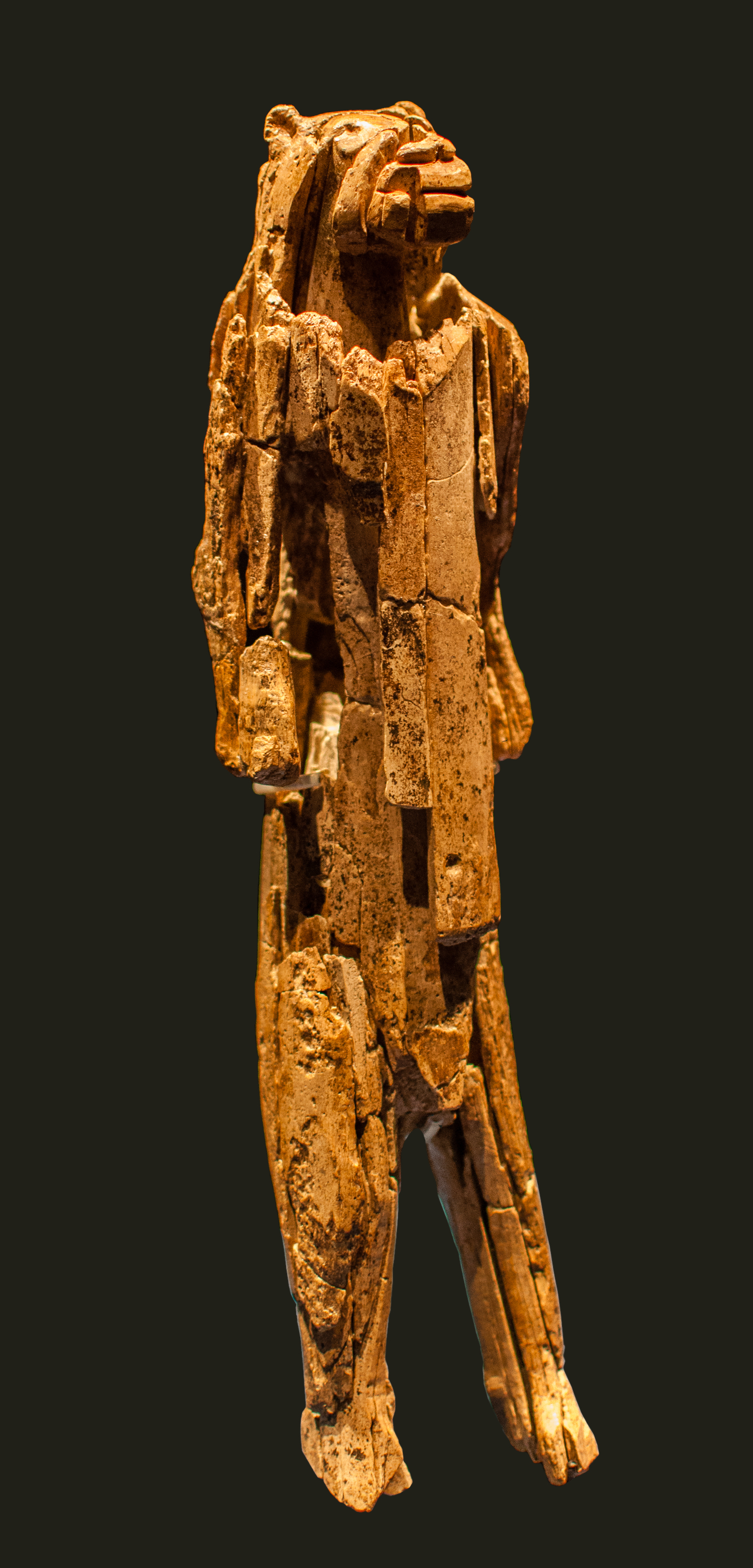|
Mesolithic
The Mesolithic (Ancient Greek language, Greek: μέσος, ''mesos'' 'middle' + λίθος, ''lithos'' 'stone') or Middle Stone Age is the Old World archaeological period between the Upper Paleolithic and the Neolithic. The term Epipaleolithic is often used synonymously, especially for outside northern Europe, and for the corresponding period in Epipaleolithic Near East, the Levant and Epipaleolithic Caucasus, Caucasus. The Mesolithic has different time spans in different parts of Eurasia. It refers to the final period of hunter-gatherer cultures in Europe and the Middle East, between the end of the Last Glacial Maximum and the Neolithic Revolution. In Europe it spans roughly 15,000 to 5,000 Before Present, BP; in the Middle East (the Epipalaeolithic Near East) roughly 20,000 to 10,000 Before Present, BP. The term is less used of areas farther east, and not at all beyond Eurasia and North Africa. The type of culture associated with the Mesolithic varies between areas, b ... [...More Info...] [...Related Items...] OR: [Wikipedia] [Google] [Baidu] |
Epipaleolithic Caucasus
Trialetian is the name for an Upper Paleolithic- Epipaleolithic stone tool industry from the South Caucasus. It is tentatively dated to the period between 16,000 / 13,000 BP and 8,000 BP. Archaeology The name of the archaeological culture derives from sites in the district of Trialeti in south Georgian Khrami river basin. These sites include Barmaksyzkaya and Edzani-Zurtaketi. In Edzani, an Upper Paleolithic site, a significant percentage of the artifacts are made of obsidian. The Caucasian-Anatolian area of Trialetian culture was adjacent to the Iraqi-Iranian Zarzian culture to the east and south as well as the Levantine Natufian to the southwest. Alan H. Simmons describes the culture as "very poorly documented". In contrast, recent excavations in the Valley of Qvirila river, to the north of the Trialetian region, display a Mesolithic culture. The subsistence of these groups were based on hunting '' Capra caucasica'', wild boar and brown bear. Trialetian sites ... [...More Info...] [...Related Items...] OR: [Wikipedia] [Google] [Baidu] |
Epipaleolithic
In archaeology, the Epipalaeolithic or Epipaleolithic (sometimes Epi-paleolithic etc.) is a period occurring between the Upper Paleolithic and Neolithic during the Stone Age. Mesolithic also falls between these two periods, and the two are sometimes confused or used as synonyms. More often, they are distinct, referring to approximately the same period of time in different geographic areas. Epipaleolithic always includes Epipalaeolithic Near East, this period in the Levant and, often, the rest of the Near East. It sometimes includes parts of Southeast Europe, where Mesolithic is much more commonly used. Mesolithic very rarely includes the Levant or the Near East; in Europe, Epipalaeolithic is used, though not very often, to refer to the early Mesolithic. The Epipalaeolithic has been defined as the "final Upper Palaeolithic industries occurring at the end of the final Last glacial period, glaciation which appear to merge technologically into the Mesolithic". The period is general ... [...More Info...] [...Related Items...] OR: [Wikipedia] [Google] [Baidu] |
Stone Age
The Stone Age was a broad prehistory, prehistoric period during which Rock (geology), stone was widely used to make stone tools with an edge, a point, or a percussion surface. The period lasted for roughly 3.4 million years and ended between 4000 Anno Domini, BC and 2000 BC, with the advent of metalworking. It therefore represents nearly 99.3% of human history. Though some simple metalworking of malleable metals, particularly the use of Goldsmith, gold and Coppersmith, copper for purposes of ornamentation, was known in the Stone Age, it is the melting and smelting of copper that marks the end of the Stone Age. In Western Asia, this occurred by about 3000 BC, when bronze became widespread. The term Bronze Age is used to describe the period that followed the Stone Age, as well as to describe cultures that had developed techniques and technologies for working copper alloys (bronze: originally copper and arsenic, later copper and tin) into tools, supplanting ston ... [...More Info...] [...Related Items...] OR: [Wikipedia] [Google] [Baidu] |
Azilian
The Azilian is a Mesolithic archaeological industry, industry of the Franco-Cantabrian region of northern Spain and Southern France. It dates approximately 10,000–12,500 years ago. Diagnostic Cultural artifact, artifacts from the culture include projectile points (microliths with rounded retouched backs), crude flat bone harpoons and pebbles with abstract decoration. The latter were first found in the River Arize at the type-site for the culture, the ''Mas d'Azil cave, Grotte du Mas d'Azil'' at Le Mas-d'Azil in the French Pyrenees (illustrated, now with a modern road running through it). These are the main type of Azilian art, showing a great reduction in scale and complexity from the Magdalenian Art of the Upper Palaeolithic. The industry can be classified as part of the Epipaleolithic or the Mesolithic periods, or of both. Archaeologists think the Azilian represents the tail end of the Magdalenian as the warming climate brought about changes in human behaviour in the area. The ... [...More Info...] [...Related Items...] OR: [Wikipedia] [Google] [Baidu] |
Epipaleolithic Near East
The Epipalaeolithic Near East designates the Epipalaeolithic ("Final Old Stone Age") in the prehistory of the Near East. It is the period after the Upper Palaeolithic and before the Neolithic, between approximately 25,000 and 11,500 years Before Present. The people of the Epipalaeolithic were nomadic hunter-gatherers who generally lived in small, seasonal camps rather than permanent villages. They made sophisticated stone tools using microliths—small, finely-produced blades that were hafted in wooden implements. These are the primary artifacts by which archaeologists recognise and classify Epipalaeolithic sites. Although the appearance of microliths is an arbitrary boundary, the Epipalaeolithic does differ significantly from the preceding Upper Palaeolithic. Epipalaeolithic sites are more numerous, better preserved, and can be accurately radiocarbon dated. The period coincides with the gradual retreat of glacial climatic conditions between the Last Glacial Maximum and the s ... [...More Info...] [...Related Items...] OR: [Wikipedia] [Google] [Baidu] |
Epipalaeolithic Near East
The Epipalaeolithic Near East designates the Epipalaeolithic ("Final Old Stone Age") in the History of the Middle East#Prehistoric Near East, prehistory of the Near East. It is the period after the Upper Paleolithic, Upper Palaeolithic and before the Neolithic, between approximately 25,000 and 11,500 years Before Present. The people of the Epipalaeolithic were nomadic hunter-gatherers who generally lived in small, seasonal camps rather than permanent villages. They made sophisticated stone tools using microliths—small, finely-produced blades that were hafted in wooden implements. These are the primary artifacts by which archaeologists recognise and classify Epipalaeolithic sites. Although the appearance of microliths is an arbitrary boundary, the Epipalaeolithic does differ significantly from the preceding Upper Palaeolithic. Epipalaeolithic sites are more numerous, better preserved, and can be accurately Radiocarbon dating, radiocarbon dated. The period coincides with the gra ... [...More Info...] [...Related Items...] OR: [Wikipedia] [Google] [Baidu] |
Upper Paleolithic
The Upper Paleolithic (or Upper Palaeolithic) is the third and last subdivision of the Paleolithic or Old Stone Age. Very broadly, it dates to between 50,000 and 12,000 years ago (the beginning of the Holocene), according to some theories coinciding with the appearance of behavioral modernity in early modern humans. It is followed by the Mesolithic. Anatomically modern humans (i.e. ''Homo sapiens'') are believed to have emerged in Africa around 300,000 years ago. It has been argued by some that their ways of life changed relatively little from that of archaic humans of the Middle Paleolithic, until about 50,000 years ago, when there was a marked increase in the diversity of Artefact (archaeology), artefacts found associated with modern human remains. This period coincides with the most common date assigned to early human migrations, expansion of modern humans from Africa throughout Asia and Eurasia, which may have contributed to the Neanderthal extinction, extinction of th ... [...More Info...] [...Related Items...] OR: [Wikipedia] [Google] [Baidu] |
Hunter Gatherer's Camp At Irish National Heritage Park - Geograph
Hunting is the Human activity, human practice of seeking, pursuing, capturing, and killing wildlife or feral animals. The most common reasons for humans to hunt are to obtain the animal's body for meat and useful animal products (fur/hide (skin), hide, bone/tusks, horn (anatomy), horn/antler, etc.), for recreation/taxidermy (see trophy hunting), although it may also be done for resourceful reasons such as removing predators dangerous to humans or domestic animals (e.g. wolf hunting), to pest control, eliminate pest (organism), pests and nuisance animals that damage crops/livestock/poultry or zoonosis, spread diseases (see varmint hunting, varminting), for trade/tourism (see safari), or for conservation biology, ecological conservation against overpopulation and invasive species (commonly called a culling#Wildlife, cull). Recreationally hunted species are generally referred to as the ''game (food), game'', and are usually mammals and birds. A person participating in a hunt is a ... [...More Info...] [...Related Items...] OR: [Wikipedia] [Google] [Baidu] |
Neolithic
The Neolithic or New Stone Age (from Ancient Greek, Greek 'new' and 'stone') is an archaeological period, the final division of the Stone Age in Mesopotamia, Asia, Europe and Africa (c. 10,000 BCE to c. 2,000 BCE). It saw the Neolithic Revolution, a wide-ranging set of developments that appear to have arisen independently in several parts of the world. This "Neolithic package" included the History of agriculture, introduction of farming, domestication of animals, and change from a hunter-gatherer lifestyle to one of sedentism, settlement. The term 'Neolithic' was coined by John Lubbock, 1st Baron Avebury, Sir John Lubbock in 1865 as a refinement of the three-age system. The Neolithic began about 12,000 years ago, when farming appeared in the Epipalaeolithic Near East and Mesopotamia, and later in other parts of the world. It lasted in the Near East until the transitional period of the Chalcolithic (Copper Age) from about 6,500 years ago (4500 BCE), marked by the development ... [...More Info...] [...Related Items...] OR: [Wikipedia] [Google] [Baidu] |
Pottery
Pottery is the process and the products of forming vessels and other objects with clay and other raw materials, which are fired at high temperatures to give them a hard and durable form. The place where such wares are made by a ''potter'' is also called a ''pottery'' (plural ''potteries''). The definition of ''pottery'', used by the ASTM International, is "all fired ceramic wares that contain clay when formed, except technical, structural, and refractory products". End applications include tableware, ceramic art, decorative ware, toilet, sanitary ware, and in technology and industry such as Insulator (electricity), electrical insulators and laboratory ware. In art history and archaeology, especially of ancient and prehistoric periods, pottery often means only vessels, and sculpture, sculpted figurines of the same material are called terracottas. Pottery is one of the Timeline of historic inventions, oldest human inventions, originating before the Neolithic, Neolithic period, w ... [...More Info...] [...Related Items...] OR: [Wikipedia] [Google] [Baidu] |
Neolithic Revolution
The Neolithic Revolution, also known as the First Agricultural Revolution, was the wide-scale transition of many human cultures during the Neolithic period in Afro-Eurasia from a lifestyle of hunter-gatherer, hunting and gathering to one of agriculture and sedentism, settlement, making an increasingly large population possible. These settled communities permitted humans to observe and experiment with plants, learning how they grew and developed. This new knowledge led to the domestication of plants into crops. Archaeological data indicate that the domestication of various types of plants and animals happened in separate locations worldwide, starting in the Geologic time scale, geological epoch of the Holocene 11,700 years ago, after the end of the last Ice Age. It was humankind's first historically verifiable transition to agriculture. The Neolithic Revolution greatly narrowed the diversity of foods available, resulting in a decrease in the quality of human nutrition compared ... [...More Info...] [...Related Items...] OR: [Wikipedia] [Google] [Baidu] |
Archaeological Period
The names for archaeological periods vary enormously from region to region. This is a list of the main divisions by continent and region. Dating also varies considerably and those given are broad approximations across wide areas. The three-age system has been used in many areas, referring to the prehistorical and historical periods identified by tool manufacture and use, of Stone Age, Bronze Age and Iron Age. Since these ages are distinguished by the development of technology, it is natural that the dates to which these refer vary in different parts of the world. In many regions, the term Stone Age is no longer used, as it has been replaced by more specific geological periods. For some regions, there is need for an intermediate Chalcolithic period between the Stone Age and Bronze Age. For cultures where indigenous metal tools were in less widespread use, other classifications, such as the lithic stage, archaic stage and formative stage refer to the development of other types of te ... [...More Info...] [...Related Items...] OR: [Wikipedia] [Google] [Baidu] |










